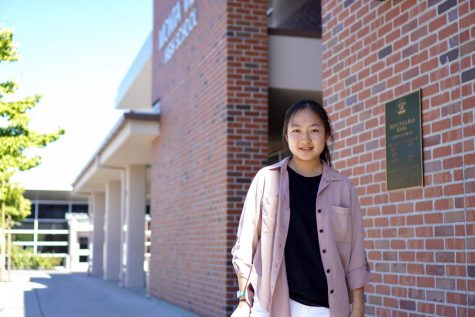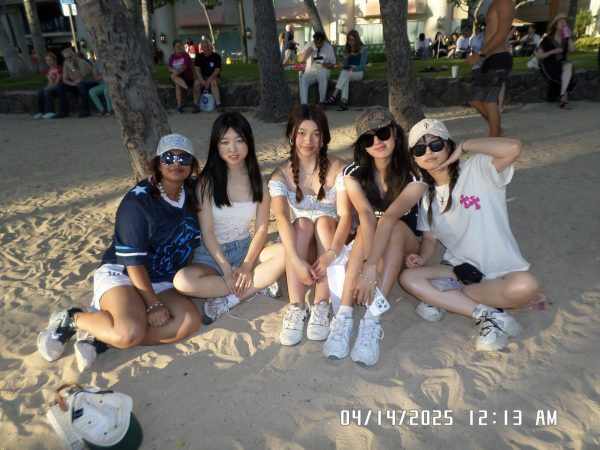The symbol of a face mask in America versus Asia
Examining the reasons why Americans aren’t encouraged to wear masks as opposed to Asian countries
As the pandemic spreads, more are looking for someone or a group of people to blame
On April 4, 2020, the CDC announced that all people in the U.S. are recommended to wear face masks to protect themselves from COVID-19. Despite this, individuals including President Trump refuse to wear one.
Additionally, recent news shows that some Asians and Asian Americans are becoming more self-conscious about wearing masks in public, especially in America, where people other than medical workers don’t commonly use them.
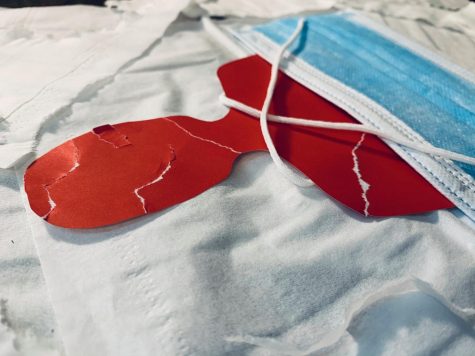
Juniors Victor Li, Annabelle Choi and Vivian Cheng share their thoughts on what wearing a mask means to them
Junior Victor Li is uncomfortable wearing a mask in public because he feels self-conscious that being an Asian American, others might associate him with the pandemic. Junior Annabelle Choi and junior Vivian Cheng agree, stating that they fear non-Asians or non-Asian Americans might not treat them the same if they were to wear one.
“As an Asian American, people will see you as having something to do with the virus, even though we were born here, we grew up here our whole lives,” Li said. “But there’s still this casual racism towards Asian Americans and seeing them as related to the disease. I think wearing a mask as an Asian American just makes people panic.”
Li, Choi and Cheng have noticed this trend and pointed to many different reasons as to why it exists.
ENVIRONMENTAL FACTORS
In addition to a safety measure for the sick, wearing face masks is a type of fashion in Korea, according to Choi. She often sees individuals wearing black masks because it is a popular trend in the country.
“In Korea, people [wear a mask] on a daily basis,” Choi said. “At least for me, as [a part of the] younger generation, wearing a mask [is] just a fashion. If you’re sick, it’s just a part of good manners in Asian culture [to wear a mask].”
According to Li, Asia has been the origin of many historical pandemics, such as the Hong Kong Flu and the SARS epidemic. In contrast, the last pandemic originating in the U.S. was the Spanish Flu of 1918. Thus, he isn’t surprised that Asian or Asian American people wear masks more often than American people.
Li points out that China is known for its high pollution. With high concentrations of PM2.5 — an air pollutant that causes health hazards — in the air, people living in China wear masks to protect their bodies from being exposed to too much particulate matter, according to Li.
MEDIA AND NEWS COVERAGE
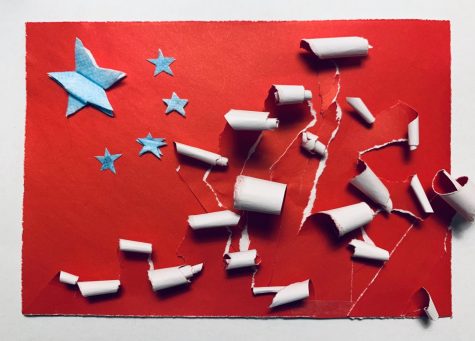
Since wearing a mask is more common in Asian countries, it is easy to use it to target Asian populations
Cheng believes that local media and news coverage also has a significant impact on how individuals view the extent that COVID-19 is dangerous for them. Many Chinese users, such as Cheng’s mother, often look to WeChat, a social media platform, for news and updates regarding the pandemic. Many articles may have been written in China or dubbed from English to Chinese — which may result in biased and exaggerated news.
Cheng states that when her mother shares articles with her about the pandemic, she would feel more cautious about COVID-19 and therefore, wear a mask more often.
“From seeing how my mom is reacting to this whole outbreak, [Asians and Asian Americans] are much more worried that they will catch things,” Cheng said. “They’re much more paranoid, and therefore, they’ll go to a much greater extent to protect themselves.”
Cheng points out that media coverage from Asian platforms are different from those of American platforms due to cultural differences and values in each country.
CULTURE AND VALUES
Choi and Cheng believe that some Asian countries, such as China, are more responsive to the pandemic compared to the U.S. Once news about COVID-19 started to spread, workers in China quickly built hospitals to accommodate their patients — they were able to build two in a week.
“If people always have the belief that it’s not gonna come to us, we’re invincible, it’s not gonna happen to us, then they wouldn’t be driven to want to take those extra measures to protect themselves,” Cheng said. “Whereas, if you’re in a country where you’re thinking, ‘Oh, it could hit us at any point,’ it’s better to be safe than sorry.”
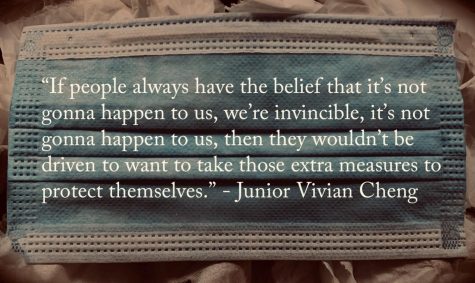
According to Junior Vivian Cheng, the U.S. should take precautions earlier next time so consequences are not as impactful
Choi agrees, stating that the attitude the U.S. has taken towards the virus is directly reflected in their slow healthcare and governmental systems.
“I’ve seen multiple cases here in America where people need to try to fight off germs and [to] push back going to the hospital [until the] very last resort, which is something [that] is definitely not seen in Asian countries,” Choi said. “I think this is directly tied towards how the healthcare system is not that great here.”
Along with the slow responses, the U.S. feels a greater amount of hesitation to wear masks due to denial, according to Li.
“Initially, I think a lot of Americans made fun of how other countries had COVID-19,” Li said. “And now that we have it, it’s not so funny anymore. I think not wearing a mask is denial [of] the fact that America is being hit pretty hard by COVID.”
RACE
Race further magnifies the differences between each country’s culture and values when considering whether or not individuals wear masks.
Li starts by explaining that during pandemics such as COVID-19, it is easy to associate items used for protection like masks, gloves and wipes with already being sick with the virus.
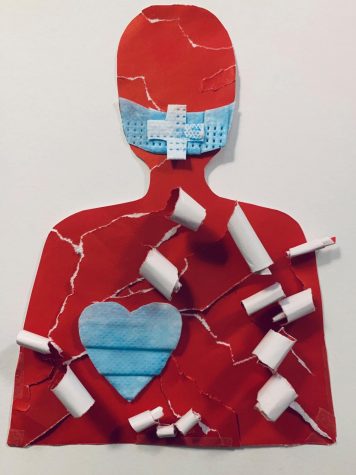
When others associate “China” with “virus,” it causes them to automatically think of China and Chinese people as a dangerous virus that threatens others
“Masks have been so symbolic of the pandemic,” Victor said. “A lot of news revolves around masks in a weirdly obsessive way. You see news about someone hoarding masks, or there aren’t enough masks, or a country is trying to get masks or people aren’t wearing masks. I think there’s going to be this permanent connotation of the pandemic that’s going to be attached to masks in the future.”
Since COVID-19 originated from Wuhan, China, Cheng feels that media coverage makes it easier for non-Asians to associate all individuals in China with the region, thus enforcing a negative stereotype. Because of this negative generalization, along with China limiting media coverage, it is easy for many to put the blame on the entire state of China.
Li, Cheng and Choi believe that masks make it easy for non-Asians to implicitly associate viruses with Asian people because most Asians wear them. To prevent themselves from being targeted and discriminated against, Cheng believes that many individuals refrain from wearing masks.
“[Wearing a mask] would draw more attention towards [Asians or Asian Americans] and heighten the bias against them,” Cheng said. “[When others] associate [masks] with the general race of Chinese people, then, they’ll turn a blind eye; [but] what they’re doing is actually wrong and that stereotype is not true.”
Meanwhile, Li expects that American exceptionalism — the idea that America is unique and special — is also a significant factor in determining why the U.S. is hesitant towards wearing masks.
“American exceptionalism, this perverted form of patriotism, takes the shape of thinking about America [as] perfect and [more] immune to these kinds of [diseases than the] so-called dirtier countries like China,” Li said.
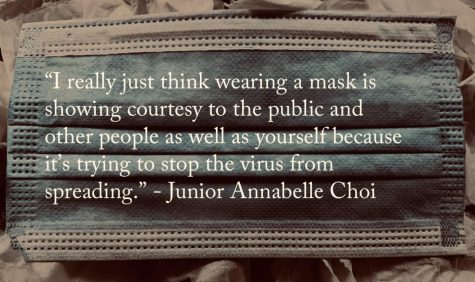
According to Junior Annabelle Choi, wearing a mask should be a way to show respect and support for others’ well-being
On the one hand, Li thinks this idea is beneficial because America is able to encourage other nations to side with democratic beliefs, human rights and individual freedom. However, Li believes it also results in U.S.’s belittlement of other countries.
To maintain their image, the U.S. must show strength in controlling the coronavirus, according to Li. However, wearing masks signifies that they are not strong enough to manage the outbreak because they are being heavily affected by it. Thus, Li feels that people in the U.S. try to avoid wearing masks.
“[There’s people] not wanting to seem vulnerable, not wanting to seem like we’re at the same level as China, which Trump vilifies,” Li said. “There’s this idea that we’re better than China, [that] we are above countries that are hit by a pandemic, [that] we are not vulnerable to a pandemic. We should not be vulnerable to a pandemic.”
Li, Choi and Cheng believe that these assumptions, stereotypes and values should not justify the spread of racism towards Asians and Asian Americans. They hope that masks can be destigmatized before another pandemic like COVID-19 hits the globe.
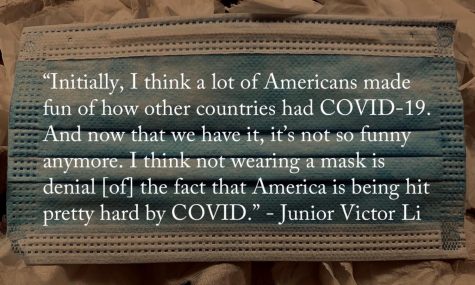
According to Junior Victor Li, not wearing a mask is a way for Americans to express their denial that COVID-19 has created an impact
“I really just think wearing a mask is showing courtesy to the public and other people as well as yourself because it’s trying to stop the virus from spreading,” Choi said. “Masks should be required when you leave the house. Being six feet apart is not enough in my opinion.”
To Choi, change starts with the U.S. healthcare system. On average, 16.9% of the American population doesn’t have insurance to afford medical visits. She has heard about cases where individuals have lost their lives due to the lack of financial capability. Along with their slow response to the virus, Choi feels that the U.S. doesn’t prioritize health enough, which makes its citizens do the same.
“One change that I would like to see is [change in] the public healthcare system in the United States [to] figure out a way to allocate more money towards alleviating insurance [or] health care systems in general [so] anyone can go, which would probably lead to more people being more conscious about wearing a mask,” Choi said. “It has to start with the governmental level, where they take it more seriously so that individuals themselves start taking health more seriously.”
